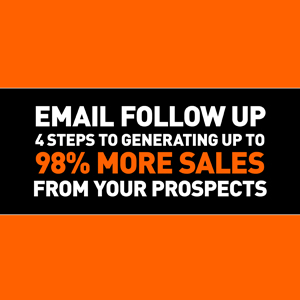4 Steps to an Effective Email Drip Campaign
Updated on July 15, 2021 Similar to social media, email drip campaigns are used by marketers as a tool for prospect follow-up, NOT lead generation. An email drip campaign is composed of a series of emails that are automatically sent following a predetermined schedule. The purpose of these emails are to follow up with your leads and warm them up one email at a time until they are ready to become a customer.
Similar to social media, email drip campaigns are used by marketers as a tool for prospect follow-up, NOT lead generation. An email drip campaign is composed of a series of emails that are automatically sent following a predetermined schedule. The purpose of these emails are to follow up with your leads and warm them up one email at a time until they are ready to become a customer.
FACT: 80% of sales are made on the fifth to twelfth contact.
In this article, we will go over the 4 steps you need to take in order to use an email drip campaign effectively. Let’s begin…
Step 1: Choose an Email Software Program
The very first thing you have to do is choose an email software program. There are many options to choose from, but here is a list of some of the more popular ones:
- MailChimp
- Aweber
- Constant Contact
- iContact
- InfusionSoft
Each of these programs has its own pros and cons, so you need to do your research to see which one would work best for you. They are all capable of providing you with a quality email drip campaign.
A special feature that you should consider looking into is auto-responding emails. Some email programs can send out emails when certain triggers are met, like making a purchase or signing up for your blog. You can then use your email drip campaign to take that prospect from interested to a customer, or even to cross-sell your other products. This isn’t something that is necessary, but if you think it would help your business, you should be aware of it.
There are two main points you need to consider when deciding on an email software program:
1. How much does it cost?
You may find some email programs that are free up to a certain number of subscribers, or they may have a free version you could use, whereas others you will have to purchase. Depending on your situation, you might want to consider one of the premium paid services, otherwise you’ll be fine with a free program.
2. Is it user-friendly, or does it require technical know-how?
If this is your first time using an email drip campaign, you may want a program that will be able to walk you through the process of starting up. However, if you are a more experienced user, you should look for a program that has more advanced capabilities.
Step 2: Building Your Email List Database
While it may be obvious, this is vitally important: in order to send an email drip campaign, you have to have a database of email addresses. As simple as this seems, you need to make building your database of emails a priority.
You should be collecting email addresses through each of the following methods:
- Your receptionist is collecting email addresses from every caller
- You have contact forms on your website and landing pages
- You have an email subscription form on your blog
You will need to take ALL of your prospects’ email addresses and put them into your email list database so you can use it for the drip campaign. Every time you earn a new lead, you have to add their information into your database as well. This will help you continually grow the reach of your email marketing.
Step 3: Choose an Email Drip Schedule
Now that you have an email drip program and all the email addresses to mail to, it’s time to look at the logistics of your drip campaign. Some common questions are, “How many emails should I send during a campaign?” and “How often should I send them?”
Take a look at your company’s average sales cycle, which is the average amount of time it takes a customer to buy from you after they have made their first inquiry. Decide on the number of emails you want to send during that period of time.
For example: If your average sales cycle is 4-6 weeks then you will want to send one or two emails a week for 6 weeks. If your sales cycle is shorter, maybe 5 days or less, you may want to send an email a day. If your sales cycle is longer, like a year or more, you may want to send biweekly or monthly emails. It is also a common practice to send emails more frequently just after initial inquiry, then slow down as the lead gets older.
Step 4: Choose the Right Content
This is the most important part of this article. What are you going to say to all your prospects with your emails?
You are using these emails as an opportunity to educate prospects about your company in a much more personal way. By not focusing on selling your product, you make them much more likely to buy from you. Ironic, I know. You have to approach this as purely building trust with your prospects. Prospects have already shown some level of interest in your company (filling out a form, calling your office, making a previous purchase, etc.) so now you are taking the time to reconnect with them. You will be able to turn their interest into a sale, by educating them more about your company, your products, your services, your industry, your reputation, etc.
The most important aspect of your email drip campaign is to keep your email personal. If your email sounds and reads like an advertisement, it will get marked as SPAM right away.
Here are some examples of great email content:
- Customer testimonials
- Description of a product or service’s benefits
- Facts or background on your company
Let’s break the email down by each piece…
Subject Line:
This is an incredibly important piece of your email. For many email users, this is the only opportunity you have to convince people to open and read your email. You have to grab the recipient’s attention, and more importantly your tone needs to be personal and conversational. We find that subject lines that read like an advertisement performed worse than those that sounded like a personal message. Using a subject line to promote a discount may not be the best idea because it sounds too much like a sales pitch. A personal statement of a benefit your product or service provides to prospects, or an engaging greeting will usually receive a much higher open rate.
- 64% of people say they open an email because of the subject line
- Discount terms in subject lines generally performed below average
- A personalized subject line is 22.2% more likely to be opened
The Message:
You need to tell your prospects how you are able to help them as quickly as you can. The average person receives over 100 emails every day so they are not likely to read three paragraphs of copy. The solution to having your email read is to use short blocks of text and bullet points of useful information, or tell them of a way you can make their lives better or easier. As with the subject line, it needs to sound personal and informal to hold their attention.
Check out an example of what an email drip campaign could look like for a Martial Arts gym:
Week 1
This message will only introduce the prospect to the owners and staff of the Martial Arts gym. It will also inform the prospect that they offer an after-school program for children and adults.
Week 2
This message will go into detail about the physical health benefits of learning Martial Arts; flexibility, balance, strength, agility, overall fitness and physical preparedness, etc.
Week 3
This message will go into detail about the mental benefits of learning Martial Arts; learning inner calmness, better focus and concentration, self-confidence, strong character, etc.
Week 4
This message will show some testimonials of your classes by former students. These tell prospects how your classes helped them reach their full potential as a healthy, well-balanced person both inside and out.
Week 5
This message will tell your prospects about your qualifications, which belts your staff have achieved, as well as the amount of teaching and training experience you have.
Week 6
In the last email, list out your class times and prices, stressing one last time the benefits of reaching their full potential through Martial Arts
This is a gradual process that provides your prospects with everything they would need to know about why they should sign up for your Martial Arts classes. You build credibility and allow the prospects to develop more trust in your company after each email they receive. Ideally, at one point during the campaign your prospect will read a piece of information that makes them want to call and become your customer. It is important to include a call to action in every email in order to draw a response from your prospects. You can’t assume your prospect knows what to do even if they read something they liked in your email. Tell them exactly what you want them to do.
Now that you know all about email drip campaigns, you can being converting prospects into customers. You just have to get started…





